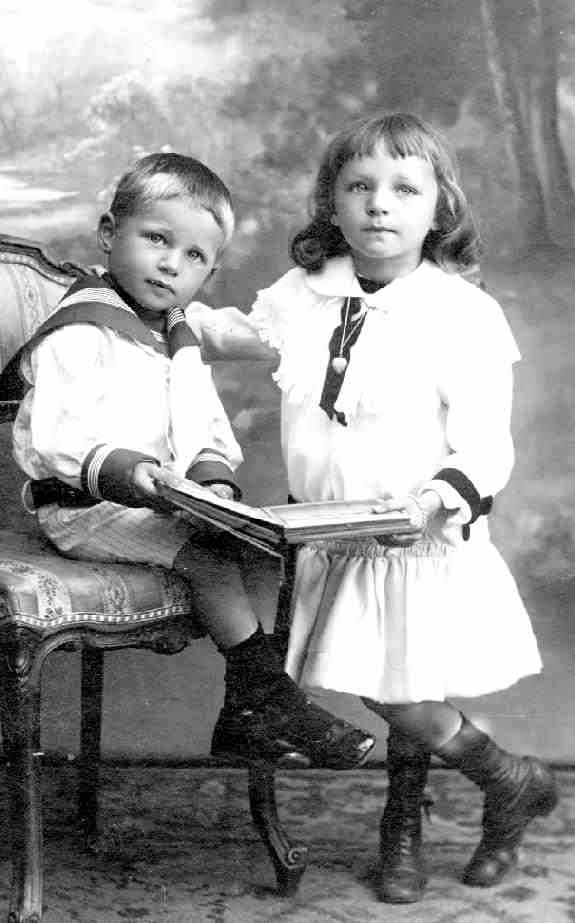
Children's Literature: Belgium

Figure 1.--We have little information on Belgian children's literature at this time. We do note an image of Belgian children in the early 20th century reading illustrated children's books. Some of these early books for younger children were not bound pages, but rather thick pages that opened up in a chain fashion althought they folded together in book form. This portrait is undated. All we know is that it was taken in Anvers, which means Antwerp and is in Flanders. Image coutesy of the MS collection.
|
We have little information on Belgian children's literature at this time. We do note an image of Belgian children in the early 20th century reading illustrated children's books. Some of these early books for younger children were not bound pages, but rather thick pages that opened up in a chain fashion althought they folded together in book form. We have seen similar books in Germany and other countries. The image here is undated, but we would guess was taken about 1910. The little boy has a short, cropped hair without bangs and wears a sailor suit. Note how the middy bloiuse has sleeves to long for him--obviously meant to grow into. The blouse is white, but his short pants are stripped. He wears dark socks with strap shoes. His sister has bangs with long hair and wears a white dress with a locket. All we know is that it was taken in Anvers, which means Antwerp and is in Flanders.
Children's Literature
We have little information on Belgian children's literature at this time. We do note an image of Belgian children in the early 20th century reading illustrated children's books. Some of these early books for younger children were not bound pages, but rather thick pages that opened up in a chain fashion althought they folded together in book form. We have seen similar books in Germany and other countries. One factor which has to be considered in assessing Belgian literature is the language division in the country. Belgium is a small cvountry. Thus books and magazines from other countries were widely available and affected the ability of Belgian authors and publishers to compete. French readers had access to the much larger French publishing industry. The Flemish had access to Dutch publications. Here because Dutch is close to German, presumably German publications also circulated. Of course in connection with the picture books for pre-readers seen here, language was not a major factor. I am unsure as to what extent the Belgian Government attempt to restrict the import of foreign books and publications to protect domestic authors and publishers. A Dutch reader tells us, "There were no import duties on foreign books anywhere in Europe."
Image
The image here is undated, but we would guess was taken about 1910. The little boy has a short, cropped hair without bangs and wears a sailor suit. Note how the middy bloiuse has sleeves to long for him--obviously meant to grow into. The blouse is white, but his short pants are stripped. He wears dark socks with strap shoes. His sister has bangs with long hair and wears a white dress with a locket. All we know is that it was taken in Anvers, which means Antwerp and is in Flanders.
Belgian Place Names
Tracking down just where Anvers was led us back to the language division in Belgium which of course is a factor in Belgian literature, including children's literature. Anvers is the French name for Antwerp. The Dutch (Flemish) name is Antwerpen. Most cities in Belgium have two names, French and Dutch. Brussels is Brussel in Dutch and Bruxelles in French. Leuven and Louvain, Luik and Liege, Brugge and Bruges, Gent and Gand, Bergen and Mons, Kortrijk and Courtrai, etc. There always has been a linguistic war in Belgium. In Flemish-speaking areas they refuse to display or mention the French name of a city and the same goes for the Walloon parts of the country where everything is only in French and
the Dutch names are being ignored. It was different in the 19th century when Belgium became a country. At that time everything was in French, even in 100 percent Flemish cities, but the "Vlaamsche Beweging" (Flemish Movement) fought hard to achieve the situation
we have now, where preference for the majority-language is the law. Only the capital, Brussels, is bi-lingual. There all street names are in Dutch and in French.
HBC

Navigate the HBC literary pages' Historical Clothing Web Site:
[Return to the main Main children's literary page]
[Return to the main Main literary page]
[Return to the main Main Belgian page]
Navigate the Boys' Historical Clothing Web Site:
[Introduction]
[Activities]
[Biographies]
[Chronology]
[Clothing styles]
[Countries]
[Girls]
[Bibliographies]
[Contributions]
[FAQs]
[Glossaries]
[Satellite sites]
[Tools]
[Boys' Clothing Home]
Created: February 26, 2003
Last updated: February 26, 2003



